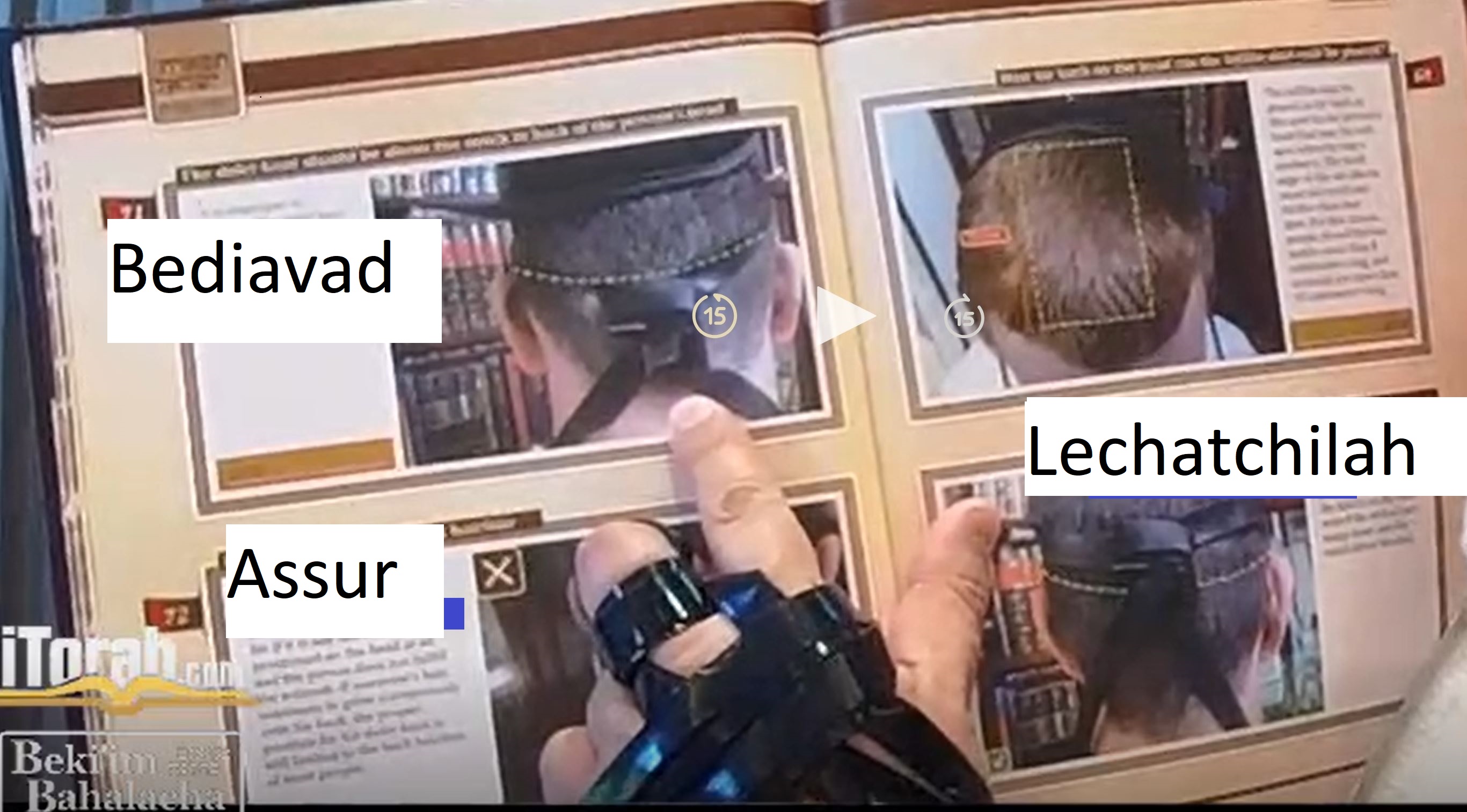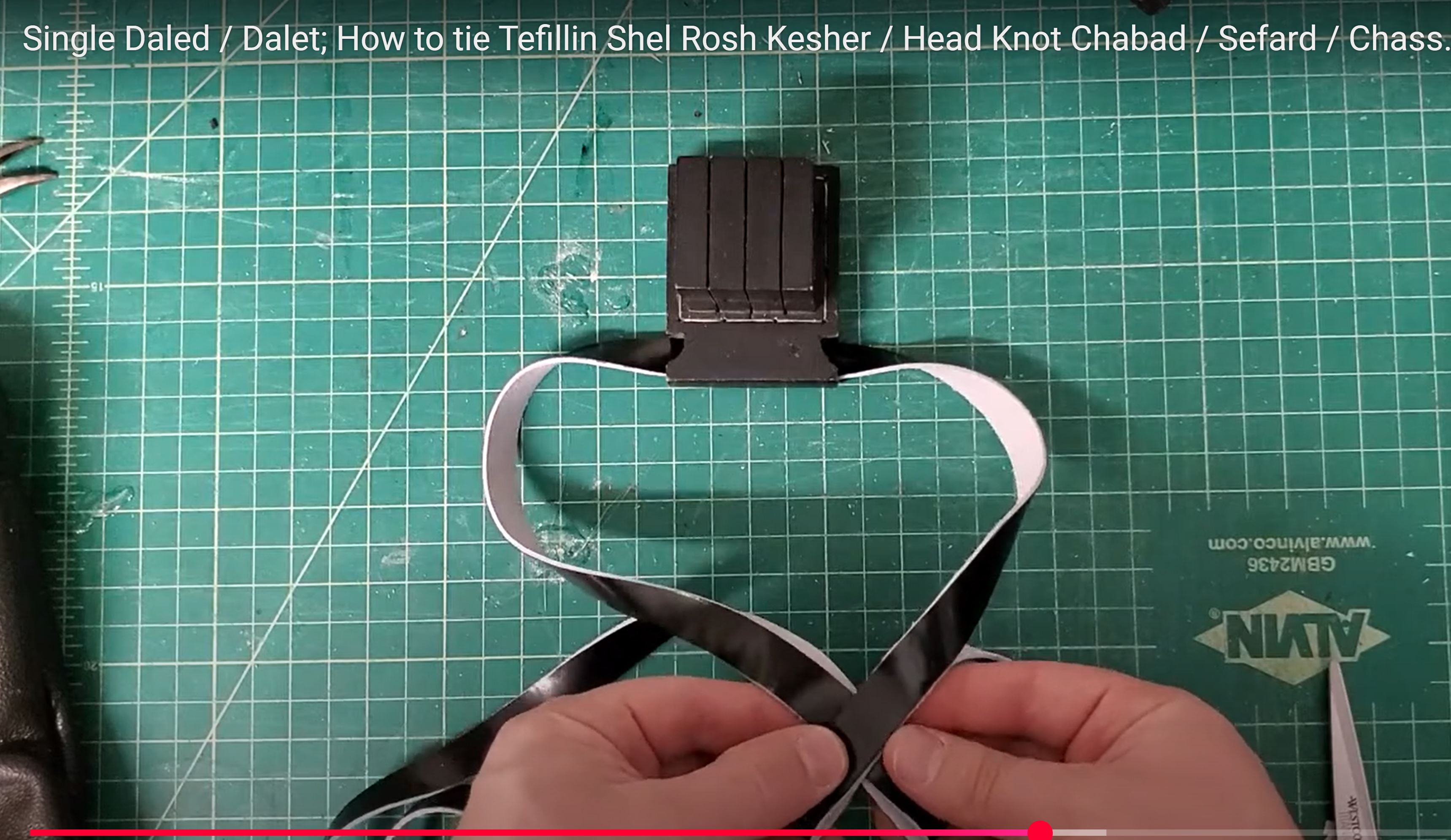Status:In Progress
Date: Iyar 15 5785
IYH this Torah post is dedicated to teshuvah gamour of דָּנִיֵּאל יַעֲקֹב ben אסתר
tl/dr:
The main, horizontal part of the dalet-knot of the tefillin shel rosh should be positioned on the bone of the skull, above the guma (depression or protuberance at the back of the skull); the vertical part of the knot may hang down behind the guma.
If the kesher shel rosh (knot of the head tefillin) is placed entirely below the back hairline (on the neck), it is considered as if one has not put on tefillin at all, and the mitzvah is not fulfilled.
How to untie and reknot the Dalet tutorial by Sofer R. Kass (Monsey, NY)
Shiur by R. Mansour chlita
Beki'im BaHalacha Volume 4 Summary Day 70, covering Beki'im BaHalacha Pages 172-174
Summary: This shiur by Rav Eliyahu Mansour delves into the precise halachot concerning the placement of the tefillin shel rosh (head phylacteries), focusing on the correct positioning of the kesher shel rosh (knot of the head phylacteries) at the back of the head and the bayit (housing) at the front, in line with "bein einekha" (between your eyes). The shiur emphasizes the importance of the tefillin being securely fastened and properly sized, drawing from sources like the Shulhan Arukh, Mishnah Berurah, and offering a fascinating biological insight into the phrase "bein einekha."
'Fun fact': A physician listener, Paul Kerlansky, pointed out a remarkable alignment between halacha and biology regarding the placement of the tefillin shel rosh. The Torah's instruction "bein einekha" (between your eyes) corresponds precisely to the external point on the head located above the optic chiasm. This is the internal site where the optic nerves from both eyes cross and merge information before it is processed by the brain. Thus, the tefillin is placed where all sight information converges, showcasing the profound truth and accuracy of the Torah.
Questions: * Question from a past shiur: Why does the Torah instruct to place the tefillin "bein einekha" (between your eyes), when its actual position is higher on the head, necessitating commentaries to explain it's not literally between the eyes? Why didn't the Torah just state the exact location? * Rav Mansour's Answer: The Rav shared the physician's explanation (detailed in the 'Fun fact' above) that the tefillin shel rosh is indeed placed at the external point corresponding to the optic chiasm, where visual input from both eyes merges. This demonstrates that the Torah's phrasing is deeply accurate. "Never question the Torah," the Rav emphasized, as its wisdom, sometimes revealed later, is perfect.
One-Sentence Takeaway: For the proper fulfillment of the mitzvah (commandment), ensure your tefillin shel rosh is meticulously placed—the bayit (housing) centered in the front and the kesher (knot) correctly positioned on the skull at the back—and that the straps are snugly fastened.
Halachic Principles: * The mitzvah of tefillin demands precise placement for both the bayit (housing) on the forehead and the kesher (knot) at the back of the head. * Tefillin must be securely fastened (mehudakim) to the head; merely balancing them is insufficient to fulfill the obligation. * The kesher shel rosh (knot of the head tefillin) must be positioned on the bone of the skull at the back, specifically on the oref (nape of the neck/back of skull), not the tzavar (neck). * No part of the kesher shel rosh should rest below the natural anatomical hairline at the back of the neck, even if hair grows lower. * When borrowing tefillin, it is crucial to ensure they fit properly; an ill-fitting set can invalidate the mitzvah and render the beracha (blessing) in vain.
Halachic Rulings: * The main, horizontal part of the dalet-knot of the tefillin shel rosh should be positioned on the bone of the skull, above the guma (depression or protuberance at the back of the skull); the vertical part of the knot may hang down behind the guma. * If the kesher shel rosh (knot of the head tefillin) is placed entirely below the back hairline (on the neck), it is considered as if one has not put on tefillin at all, and the mitzvah is not fulfilled. * When borrowing tefillin, if the straps are too loose for one's head and are not adjusted to fit snugly, the mitzvah is not fulfilled, and any beracha (blessing) recited is considered l'vatala (in vain). * The bayit (housing) of the tefillin shel rosh must be positioned in the center of the head, directly above the space between the eyes. * According to the Avne Nezer, if one borrows tefillin and must adjust the knot, the mitzvah may not be fulfilled because the owner will retie it, making the borrower's knot temporary; a tefillin knot should ideally be tied with the intention of permanence (though many Aharonim dispute this stringency).
Sources: * Torah (Devarim 6:8): "U'kshartem l'ot al yadekha v'hayu l'totafot bein einekha" (And you shall bind them as a sign upon your arm, and they shall be for ornaments between your eyes). * Talmud Bavli, Masechet Menahot (35b, 37b): Discusses the placement of tefillin. * Shulhan Arukh (Orach Chaim, Siman 27, Sif 9, 10, 11): Details the laws of tefillin placement. * Rambam (Mishneh Torah, Hilkhot Tefillin, Perek 4:1): Specifies the location of the knot. * Mishnah Berurah (Siman 27, Sif Katan 33, 35, 36): Offers practical guidance on tefillin placement.
Key Quotes: * "Furthermore, everyone should make sure that the tefillin shel rosh is actually fastened onto his head. If it is only balanced in place but it will slip off if he bends over, this is not considered wearing tefillin at all and he is not fulfilling the mitzvah." (Beki'im BaHalacha, p.172) * "In any case, it is vital to make sure that no part of the knot is positioned below the back hairline... if someone positions it below the hairline it is the same as not putting it on his head at all." (Beki'im BaHalacha, p.173) * "It is vital that the loop of the strap fit snugly on the person's head... if the loop is lying loosely on his head the bayit will inevitably fall forward onto his forehead, or the dalet-knot will fall down onto the back of his neck. Either way, he cannot fulfill the mitzvah of tefillin." (Beki'im BaHalacha, p.174) * "Never question the Torah. You could sit with a question for 50 years, and ultimately the Torah is going to be perfect. HaShem knows exactly why He used that." (Rav Mansour) * "The dalet knot of the tefillin should be positioned high on the skull... it must not be positioned down on the back of the neck." (Rav Mansour, explaining Rashi on Menahot 35b)
Scenarios: (These scenarios are NOT PSAK halacha (practical halachic rulings) but illustrative examples based on the principles discussed.) * Scenario 1: A man is in a hurry and his tefillin shel rosh feels a bit loose. It stays on his head if he doesn't bend over too much. * Guidance: The tefillin must be actually fastened and fit snugly. If it's merely balanced and could slip, he is not fulfilling the mitzvah. He should take the moment to tighten the strap properly. * Scenario 2: Someone has a very low natural hairline at the back of their neck, or their hair grows quite far down. They find it most comfortable to place the kesher shel rosh (knot of the head tefillin) where their hair ends. * Guidance: The kesher must be on the oref (back of the skull/nape), on the bone, and no part of it should be below the anatomical back hairline (where the skull meets the neck), irrespective of where hair growth extends. He must ensure the knot is positioned higher up on the bony part of his skull. * Scenario 3: A man borrows tefillin from the synagogue. The head strap is noticeably too large for him, but he puts them on anyway without attempting to adjust the knot. * Guidance: If the loop is too large and not adjusted for a snug fit, he will not fulfill the mitzvah of tefillin. If he recites a beracha (blessing) in this situation, it is considered a beracha l'vatala (blessing in vain). He must adjust the strap; if unable, he should ideally seek another pair or consult a Rav. * Scenario 4: While putting on his tefillin shel rosh, a man notices the bayit (housing) is slightly off-center, positioned more towards the right side of his forehead. * Guidance: The bayit must be positioned in the center of the head, directly above the space between the eyes. He should carefully adjust the bayit to ensure it is correctly centered. * Scenario 5: A student in a Yeshiva consistently wears his fedora pulled down firmly over his tefillin shel rosh during Shacharit (morning prayers). * Guidance: He should be cautious. If wearing a hat over tefillin, it must be placed far enough back on the head so that it does not press on or displace the tefillin bayit from its correct position on the forehead. Pushing the bayit forward onto the hairless part of the forehead would invalidate the mitzvah.

